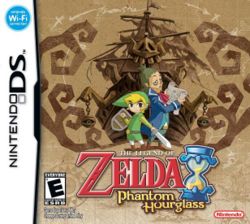The Legend of Zelda: Phantom Hourglass

| |
| The Legend of Zelda: Phantom Hourglass | |
| Developer | Nintendo EAD |
| Publisher | Nintendo |
| System | Nintendo DS, Wii U Virtual Console |
| Release Date | Nintendo DS JP June 23, 2007 US October 1, 2007 AU October 11, 2007 EU October 19, 2007 Wii U Virtual Console PAL November 13, 2015 US May 12, 2016 JP August 3, 2016 |
| Genre | Adventure |
| Gallery | Gallery |
| Rating | ESRB: E |
The Legend of Zelda: Phantom Hourglass is the fourteenth Zelda game and the first one on the Nintendo DS.
Story[edit]
The game continues shortly after the events of The Wind Waker. Tetra brings Link and her pirates in search of the mysterious Ghost Ship, in hopes of proving it to be a fraud. They eventually find the Ghost Ship, but Tetra is abducted after boarding, and in his attempt to board the Ghost Ship Link is tossed overboard and separated from the pirates. He eventually wakes on Mercay Island. There he receives instruction from a mysterious old man, Oshus.
From there Link sets out to find a way to stop the Ghost Ship by awakening the three spirits hidden in various temples, while learning more about the Ghost Ship and the evil controlling it. He eventually finds two companions- the fairy Ciela, who provides advice, and the cowardly adventurer Linebeck, who provides transportation across the islands in the form of his steamboat.
Gameplay[edit]
Phantom Hourglass puts a unique spin on traditional Zelda gameplay. Link is controlled solely through use of the touch screen. The buttons can only be used to bring up menus and equip weapons (both of which can also be done through the touch screen). The stylus can even be used to mark lines on maps and solve several puzzles which involve drawing certain symbols on doors.
As this game continues from The Wind Waker, ocean travel once again returns, but several innovations have been made to make the sailing process more enjoyable. This time the boat's route must be drawn along the map, and there is no longer any reliance on wind. Throughout the ocean, there are also obstacles to jump and enemies to shoot with the cannonball. It is also once more possible to fish and send a hook down for treasure at the bottom of the sea, but both functions have been turned into minigames. The game's sea is divided into four sections, and sea charts must be found to explore these waters.
Aside from the usual temples, there is also a temple that must be visited multiple times in the game, the Temple of the Ocean King. In this temple, Link's health is slowly drained except at special safety points, but after collecting the Phantom Hourglass, Link will have a time limit (depending on how much sand is found) to explore the temple before losing health. Additional twists include indestructible enemies called Phantoms that hunt Link down and will take time away from his visit if they hit him.
The game also has a multiplayer mode that is compatible with Wi-Fi. But it is unlike previous multiplayer Zeldas such as Four Swords, as it is set in the Temple of the Ocean King and is for only two players. Each Link takes turns in grabbing Force Gems and placing them in their proper pedestals. When one player is controlling Link, the other player can control the Phantoms and plot their movements in order to sabotage the other player.
Continuity Notes[edit]
- This game acts as a direct sequel for The Wind Waker. Link, Tetra, her pirates and Salvatore are the only characters to actually reappear. The character Nyeve also acts as a parody of the Hero of Winds and makes several references to The Wind Waker. It is, of course, set within the "adult timeline" branch of the official timeline and is followed by Spirit Tracks.
- The end of the game is oddly similar to the ending of Link's Awakening, particularly with the implication that the adventure was just a dream. However, Phantom Hourglass implies that the adventure was more than just a dream, which seems to be supported by references in Spirit Tracks. Additionally, Oshus turns out to be a deity-like whale, which seems similar to the Wind Fish, although they are different types of whales.
- One collectible item is the "Ruto Crown", which refers to Ruto from Ocarina of Time.
Legacy[edit]
Ports/Remakes[edit]
- In 2016, it was released for download on the Wii U as part of its Virtual Console.
Sequels[edit]
It was followed by The Legend of Zelda: Spirit Tracks, which had a similar gameplay system and acted as a sequel set a hundred years later. It also featured a train instead of a boat.
See Also[edit]